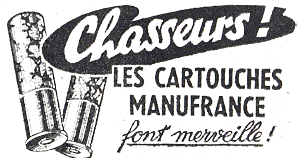|
Manufrance Luminor Folding pour Plaque (Jousset) |

Manufactured or assembled in France from (Circa) 1920 to (Circa) 1920.
Index of rarity in France: Infrequent (among non-specialized garage sales)
Inventory number: 14964
See the complete technical specifications
Chronology of cameras Manufrance
From 1887 to 1985, Manufrance was part of the daily life of the French. Its annual catalog, long before Amazon was even imagined, was the means to purchase a wide variety of items in the most remote corners of France.
 Originally, the Manufacture Française d'Armes de Saint-Etienne, the full name of Manufrance, manufactured and sold hunting weapons. In order to reach the largest number of hunters, it also published a magazine, "Le Chasseur Français". With the advent of the bicycle, the Manufacture started producing bicycles, including the famous Hirondelle. The name was changed to the Manufacture d'Armes et de Cycles de Saint-Etienne in 1901.
Originally, the Manufacture Française d'Armes de Saint-Etienne, the full name of Manufrance, manufactured and sold hunting weapons. In order to reach the largest number of hunters, it also published a magazine, "Le Chasseur Français". With the advent of the bicycle, the Manufacture started producing bicycles, including the famous Hirondelle. The name was changed to the Manufacture d'Armes et de Cycles de Saint-Etienne in 1901.
 Soon, sewing machines were also manufactured. It wasn't until 1911 that the name Manufrance appeared. The products offered by Manufrance diversified. Not all of them were manufactured by Manufrance itself, which merely acted as a distributor, simply putting its brand on products manufactured by a third party.
Soon, sewing machines were also manufactured. It wasn't until 1911 that the name Manufrance appeared. The products offered by Manufrance diversified. Not all of them were manufactured by Manufrance itself, which merely acted as a distributor, simply putting its brand on products manufactured by a third party.
This was the case with cameras. From 1905 to 1980 (except for interruptions due to wars), cameras were present in Manufrance catalogs with more than 50 manufacturers. These were numerous in the catalogs. The illustrations were small and did not always allow for the precise identification of the original model.
 The name "Luminor" appeared in 1907 and was initially used for an anastigmat lens, and the camera name was standardized according to a characteristic: Détective pour débutant, Folding pour plaque, Folding extra-mince etc. It was not uncommon for the same name to be used successively for different cameras. A "Luminor" plate was riveted onto the cameras. But was this the case for all cameras sold by Manufrance? From the 1950s onwards, the illustrations were larger, making it easier to recognize the cameras. Some finally bore their true names explicitly. Others were modified during their manufacture to bear the name "Luminor."
The name "Luminor" appeared in 1907 and was initially used for an anastigmat lens, and the camera name was standardized according to a characteristic: Détective pour débutant, Folding pour plaque, Folding extra-mince etc. It was not uncommon for the same name to be used successively for different cameras. A "Luminor" plate was riveted onto the cameras. But was this the case for all cameras sold by Manufrance? From the 1950s onwards, the illustrations were larger, making it easier to recognize the cameras. Some finally bore their true names explicitly. Others were modified during their manufacture to bear the name "Luminor."
All this resulted in great confusion in distinguishing Luminor models from others. It was only through the discovery of real examples that some precision could be achieved.
We recognize the robustness and solidity of Jousset's manufacturing. The shape of the scissors, their attachment points on the flap, the thickness of the flap, and the flower-shaped rivet that holds the strap are all characteristics found on many cameras attributed to the French manufacturer.
The Grégoire shutter is simple. It is common in entry-level cameras.

Historical information based on the bibliographical and genealogical research of Étienne Gérard – (His publications are distributed by the Club Niépce Lumière)
On September 12, 1838, the Hospice de la Charité in Lyon received an abandoned child by the name of Jousset. He was named Pierre Antoine. (1838, a pivotal year for photography...) Married to Marie Louise Lasser (c.1845-1913), he had a son in 1868, Gustave Pierre (1868-1956). He was a tanner in Paris, perhaps located near the Bièvres... A second son, Émile Albert (1870-?), became an architect and built the Dumont factory (the cabinetmaker for Bellieni) on Rue Bobillot in 1899, and another son, Lucien (1873-1905), became an optician. (The last two children, Alfred (1874-1920) and Célestine (1877-?), left no traces.) Pierre Antoine Jousset passed away in Champigny-sur-Marne on August 25, 1900, at his residence at 18 Avenue Bel-Air, where he was employed by the City of Paris.
Gustave Pierre Jousset was born on July 23, 1868, at 25 Rue Pernet in the 15th arrondissement of Paris, at his parents' home. In 1899, he was located at 20 Place d'Italie as a sales representative, along with his brother Émile. Émile then obtained the contract to build the new factory for Auguste Dumont (1863-1909) at 20 and 22 Rue Bobillot. It is possible that this contract brought Gustave and Auguste together. In 1901, Gustave lived at 30 Rue Bobillot, just a few houses away from the Dumont factory, and in 1902, he became the authorized representative for A. Dumont & Co.
On January 13, 1902, Gustave married Marthe Brochot, originally from Villiers-sur-Thonon, with Auguste Dumont as his witness.
Émile Robert Georges Jousset was born in Yonne on October 9, 1902, and would become a doctor. André Louis Jousset was born on May 13, 1904, and would work with his father.
After his marriage, Gustave, who was an authorized representative for his friend Auguste Dumont, became a sales agent. What were his connections with the manufacturer Gaëtan Mattioli (1855-1933)?
Did Mattioli manufacture shutters for Dumont? In any case, the similarities between the 'Gamine' range by Mattioli and the 'Indiscret Stéréo' range by Dumont demonstrate a relationship between the two companies, and it is likely that Gustave Jousset was the intermediary.
In 1907, Mattioli, aged 52, wished to find a successor. On January 1, 1908, he sold his entire business located at 7 Rue Broca to Gustave Jousset, mentoring him during the first year. Thus, G. Mattioli's shutters became G. Jousset's shutters. On May 17, 1909, while on vacation in Montgeron, Auguste Dumont passed away suddenly at the age of 46. Gustave Jousset then resumed the production of the Indiscrets folding camera range. In 1910, the buildings of the former Dumont establishment were taken over by the 'Fouue' partnership. In the early 1930s, the Chotard Company would move in. Until the eve of World War I, Gustave Jousset continued the production initiated by Mattioli and Dumont and expanded his range with the production of 'Guerry' type shutters.
After World War I, Gustave Jousset resumed his activities. In 1922, he partnered with the Hébert Company to create the Jousset & Hébert Company. The partnership was dissolved in 1924, and Jousset specialized in manufacturing folding cameras (6.5 x 9 and 9 x 12), metal plate and Film-Pack holders, metal tripods, and developing tongs, including the 'La Pince Idéale' patented by a certain Vincent Jousset in 1895. He primarily produced for resellers and left a significant portion of his production anonymous.
In 1926, his son André began working with him. Around 1933, the company's headquarters moved to 93 Rue de Gentilly, but production remained at 7 Rue Broca.
After World War II, the company was revived at 93 Rue de Gentilly under the name "Anciens Établissements Jousset, Société Industrielle de Photographie et d’Optique." Gustave Jousset seems to have passed the company on to his children, particularly his second son André.
The Kinax brand was registered on October 29, 1945. The new company filed four patents between 1945 and 1950 related to their flagship camera, the Kinax.
The 1945 patent was filed under the name of Anciens Établissements Jousset, the 1948 patent under the name of Société Industrielle de Photographie et d’Optique (IPO), and the 1949 and 1950 patents were filed under the name of Société Kinax S.A.
Interesting links or bibliography :
Add a link or element of bibliography, a picture taken with this camera, a picture of box or an ads about this camera
Your photos taken with the same camera:
Cameras from Ebay France (Manufrance) (Uploaded each 3 hours)







